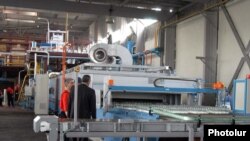The year-on-year figure is up from a GDP growth rate of 2.4 percent registered by the National Statistical Service (NSS) in January. The modest growth followed last year’s 14.4 percent contraction of the Armenian economy resulting from the global credit crunch.
The Armenian government and Western lending institutions forecast late last year that the economy will expand by only 1.2 percent in 2010. Officials from the International Monetary Fund revised the forecast upwards last month.
With retail trade and other services flat in January-February, industry remained the driving force behind the unfolding recovery. The NSS data show industrial output growing by 9.4 percent on the year and generating just over one-third of Armenia’s GDP during this period.
Rising international prices of copper and other base metals, the country’s number one export item, appear to be the main factor behind this upswing. That also explains why Armenian exports jumped by 53.5 percent to $121.4 million. And in a sign of recovering domestic consumer demand, the NSS reported an almost 17 percent rise in imports totaling $503.8 million in the two-month period.
The official statistics also indicate a further slowing of the decline of the local construction industry, the main engine of Armenia’s robust growth in the decade preceding the recession. The construction sector shrunk by 2.7 percent in January-February, compared with its 36.4 percent slump registered in 2009.
The period in question also saw a further increase in consumer price inflation. A year-on-year inflation rate of 8.2 percent recorded by the NSS is almost twice higher than the maximum inflation target set by the government and the Central Bank of Armenia (CBA) for 2010.
Citing the continuing rise in inflationary pressures on the economy, the CBA raised its benchmark re-financing rate by another 50 percent basis points to 6.5 percent on March 9. It was the third consecutive rate increase approved by the CBA board in less than two months. In a statement posted on its website, the bank attributed the higher-than-expected inflation to rising international commodity and foodstuff prices as well as the renewed growth.
The question of whether or not Armenia is emerging from its most serious economic downturn since the early 1990s is a matter of serious contention in the country’s political arena and even within its governing coalition. Trade and Economic Minister Nerses Yeritsian declared late last month that the economic crisis is over. The claim was publicly challenged not only by opposition leaders but Gagik Tsarukian, an influential businessman whose Prosperous Armenia Party controls three ministerial portfolios.
A senior World Bank official likewise cautioned recently that Armenia has only overcome “the acute phase of the crisis.”




